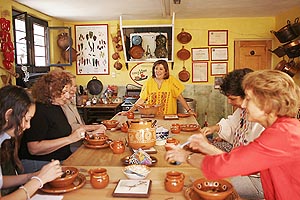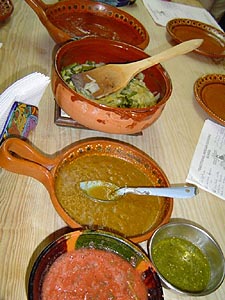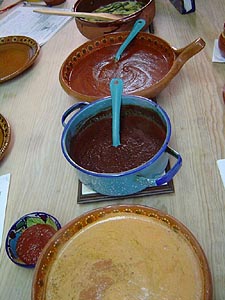 |
Eating
History
By Denis D’Amico
I never put the thoughts of history and eating together ... until
a recent trip to San Miguel de Allende in the mountains of central
Mexico where I touched and ate a part of history.
I have always loved to look at old churches and ruins, museums, pottery,
architecture and art from ages gone by when I visit different places.
You learn about the area, the people and the culture. To my delight
during this trip, I reached back 200+ years to prepare and eat the
foods of Mexico … and I was moved.
I did this with the guidance of Maria Ricaud, who has a cooking school
in the lower floor of her apartment on Calle de La Luz in the San
Antonio section of San Miguel de Allende. Maria comes from a large
family in Mexico City who prepared food for the family in traditional
ways. Maria has become the collector of the family’s recipes
and techniques with hand written recipes from her family dating back
to the late 1700’s. Maria teaches her students fundamental techniques
for handling chilies, spices and the other ingredients that make up
the salsas, adobos, pipians and mole that anchor Mexican cuisine.
Maria moves on from there to teach the diverse and wonderful cuisine
that rarely seems to make it out of Mexico to the streets of America.
Living in Oklahoma, we have a lot of Mexican food available. Most
is fair … Tex-Mex style cooking. Some is good … fairly
creative, well prepared. But Maria opened a door to cooking and salsas
that was quite honestly mystical. My job requires that I travel every
week … I have logged over 1.3 million miles on American Airlines
and also fly 100+ segments a year with Southwest Airlines …
I eat out a lot! And never have I seen sauces as complex, layered
and sophisticated as I learned from Maria.
|
 |
 |
I took an initial class with Maria to learn to cook a meal. We started
with a chili based soup with oatmeal and tomatoes blended and simmered
together to create a marvelous, lustrous soup. This was followed by
traditional Mexican white rice, mixed with crema and cheese, topped
with sautéed plantain, wrapped in a banana leaf and steamed.
A fabulous dish, presented beautifully with the stark white rice displayed
on the bright green steamed banana leaf. And the preparation method
for the rice was unique to any preparation I had seen. The rice was
washed, soaked in warm water for 20 minutes, drained, dried and then
deep-fried until the grains of rice fell into the pan sounding like
“coins falling into a fountain”.
|
Then the rice was boiled
in water (or chicken stock) until all the juices were “chased
away” creating a perfectly luxurious rice with every grain separate
and a texture that cannot be achieved any other way. I rounded out
our first lesson with a Pastel Azteca … tamale dough lightened
with beaten egg whites and egg yolks, filled with rajas (poblano peppers
strips) onions, garlic and tomatoes and topped with 1/3 of the “meringue”
and a little sugar on top to contrast the heat of the peppers. I was
hooked!!
I told Maria that I had come to San Miguel looking to learn Mexican
cooking. I am the cook in my family – my wife has not cooked
in the 22 years we have been married and that works for both of us!
Maria told me that I needed to start with chilies and salsa and work
from there. The next 4 days we did just that.
Learning from Maria was amazing. Through her enthusiasm and genuine
love for the techniques and ingredients, Maria showed me a part of
Mexican history. These methods were what her mother, grandmother and
great grand-mother used. Maria talked about the food preparation respectfully,
even reverently. She spoke of the homogenization of the food in Mexico,
happening there as it is in the US and all around the world and how
she was saddened for what appears to be the loss of these historical
techniques and combinations of ingredients that has created a cuisine
in Mexico that is unique and complex.
We delved into my language first. I asked about salsa as I knew it
in the US … a chunky, sauce that is tomato based for the most
part. Often seen in its fresh iteration … tomatoes, cilantros,
onions, jalapeño chili and lime juice, very roughly chopped
and served with chips.
|
I also asked about my concoctions of fresh fruit such as mangoes or
papaya mixed with tomatoes, onions, garlic and lime juice and the
fact that I have referred to that as salsa. Maria was patient and
kind, like a parent explaining to a child that the words to the song
they were singing since they were little were all wrong … my
ideas about salsa were totally erroneous. None of these concoctions
were salsas … We would learn what a salsa really was. And learn
I did.
We started by looking at all manner of dried chilies … mulatos,
ancho, güajillo, pasilla, chipoltle and more. We smelled, and
prodded them, then began to prepare them on the traditional comal,
(a flat, iron “plate”) dry roasting them until their smell
was intoxicating and the skin just the right amount of blistered.
We sautéed others in oil and pork lard, we softened others
in orange juice at room temperature. All were then simmered or soaked
in hot water or chicken stock. |
 |
After softening in one the various
methods we added the other ingredients … at first just onions,
tomatoes, garlic and simple spices such as marjoram, cilantro, salt
and black peppercorns. Sometime we roasted the spices, other times
we used them as is. All these ingredients went into the blender and
were pureed into a very smooth sauce.
I thought we were done … no. After blending we took the mixtures,
some stained, others right from the blender, back to the stove top
and we simmered these sauces in a cazuela (clay pot) adding salt,
chicken stock or the soaking liquid from the chilies and reducing
the mixture to create a perfect balance and roundness to the sauce.
It was magical. The tastes were full, powerful, not heat dominated
but with great layered taste. No one note stood out but all the flavors
worked together. We did 6 salsas that first day … each a different
variation on the theme. Maria was a pleasure to work with and said
that tomorrow would be fun as we moved into the adobos and pipians.
The next day brought new insights. The techniques we learned on salsas
were now expanding. The number of ingredients and the techniques to
blend these became even more intense. Toasting and grinding nuts,
seeds, and spices, then blending simmering and reducing these sauces
gave them wonderful depth and flavor. The adobos were for marinating
and simmering meats, chicken and turkey. The pipians were incredible
with the richness of pumpkin seeds at the heart of the sauce .. rich
velvety tastes balanced by the chilies and tomatoes, tomatillos and
other ingredients … again, no note taking over the symphony
of flavors in your mouth … all the notes playing a harmonious
melody. We made 6 more sauces that day.
 |
Then the day for mole. Preparing mole felt almost religious. The number
of ingredients is incredible … 25 or 26 at minimum as there
are variation on the mole theme. We started in the same way but used
multiple chilies, then added many of the same ingredients we had used
before but went on with the addition of fruits, dried and fresh, multiple
nuts, seeds, white bread, chocolate, tortillas and spices. We toasted,
roasted, sautéed, chopped, ground, blended and strained all
these ingredients until we brought back to the stove top a shamanistic
mixture that we reduced, tasted adjusted the seasoning and finally
allowed to simmer until we had what I can only describe as the finest
sauce I have ever tasted in any cuisine, any where. This mole made
your body buzz … the depth of flavor and layering of tastes
was marvelous, moving, wondrous.
The mole class was my last class with Maria as we were leaving the
next day. That evening I prepared a dinner for our group and laid
out all 13 sauces that I had made with Maria that week. I put them
in the order they were made from the more simple, one or two note
salsas, to the adobos, pipians and lastly the mole. We all took spoons
and sampled each sauce, savoring the variety and intensity of the
flavors. We were all struck by the increasing complexity of these
sauces … when you got to the mole there was s symphony playing
in your mouth. Going back to the first salsas, you could see the simple
layers, great in their own right, but more simple and straightforward
in their taste. Each new ingredient added to the adobos, pipians and
mole gave new and greater depth to the sauces. We feasted on pulled
chicken and pork wrapped in fresh tortillas and smothered in the new
found sauces of Mexico. |
And so I left Maria’s class having been given the gift of history.
Not a dry museum based look at artifacts or shards of pottery, but
a living, breathing gift. The gift of her family’s recipes and
cooking techniques. I walked away feeling privileged to have had this
history passed on to me and also duty-bound to pass these techniques
on to others in my family. My grandson, now 5, cooks with me all the
time. He will receive this gift of living history from me, so that
the lessons learned in Maria’s kitchen will continue to live
on and hopefully never be lost.
I left San Miguel changed … changed for what I learned and experienced
and have now brought home and am using with my family and friends.
I cannot think of a better history lesson. History that I can serve
to others!I had dinner tonight at a restaraunt in Oklahoma City (Adobe
Grill) that prepared food from Mexico City. The style of cooking is
very good. The chef's name is Leticia Hernandez and her husand Mario.
She knew I was going to San Miguel and asked about our trip. I told
her about you and she said she knew your name and said she knew about
you. You reputation is wide!! |
 |
By Denis D’Amico
Norman, OKLAHOMA
|
 |